
Elevation of condensed tannins in the leaves of Ta-MYB14-1 white clover (Trifolium repens L.) outcrossed with high anthocyanin lines
Abstract
Condensed tannins (CT) are highly desirable in forage as they sequester dietary protein and reduce bloat and methane emissions in ruminants. However, the widely used forage legume white clover (Trifolium repens) only produces CTs in flowers and trichomes and at levels too low to achieve therapeutic effects. Genetic transformation with transcription factor Ta-MYB14-1 from Trifolium arvense was effective in inducing CTs to 0.6% of leaf dry matter. CT synthesis has been elevated further by crossing the primary white clover transgenic line with wild type genotypes producing the related phenylpropanoids, anthocyanins. CT levels in leaves were highest under the anthocyanin leaf marks associated with the “red midrib” trait; however, there was no evidence for CT accumulation in leaf sections with the “red V” anthocyanin marking. Ta-MYB14-1 was stably inherited in two generations of crosses, and T2 progeny produced up to 3.6-fold higher CTs than the T0 parent. The profile of small CT oligomers such as dimers and trimers was consistent in T0, T1, T2, and BC2 progeny and consisted predominantly of prodelphinidins (PD), with lesser amounts of procyanidins (PC) and mixed PC:PD oligomers.
Citation
Roldan, M., Cousins, G., Fraser, K., Hancock, K., Collette, V., Demmer, J., Derek, R.W., Caradus, J., Jones, C.S. and Voisey, C. 2019. Elevation of condensed tannins in the leaves of Ta-MYB14-1 white clover (Trifolium repens L.) outcrossed with high anthocyanin lines. Journal of Agricultural and Food Chemistry









